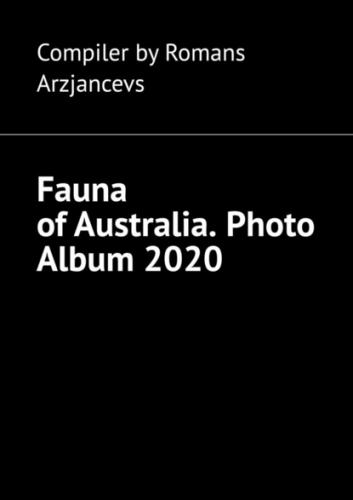Compiler Romans Arzjancevs
ISBN 978-5-0051-5032-5
Created with Ridero smart publishing system
Compiler by ROMANS ARZJANCEVS
FAUNA OF AUSTRALIA
PHOTO ALBUM
2020
NEW SOUTH WALES
KOALA
– Koalas live over a range of open forest and woodland communities but ultimately their habitat is defined by the presence of a select group of food trees. Koalas are found in higher densities where food trees are growing on more fertile soils and along watercourses.
– Koalas are subject to a range of diseases which can affect their life expectancy. For example Chlamydia is a bacterial infection affecting many koalas in South East Queensland. The stress-related disease weakens the immune system and can cause blindness and reproductive tract disease.
– A koala sleeps for around 20 hours a day.
– Koalas are asocial animals, congregating only during the breeding season. They usually form large, loosely organized groups in areas with abundant suitable trees, with a single individual per tree. During the rest of the year, koalas tend to live solitarily, showing very little social behavior.
BLACK FLYING FOX
– The Black flying-foxes are nocturnal animals that are active during the nighttime hours. They rest by day in large roost called camps. A single such camp may contain as many as hundreds of thousands of Black flying-foxes, although camps in the Northern Territory are usually contain less than 30,000 individuals.
– When cold or wet, these animals warm up by wrapping their wings tightly around themselves. When it gets hot, they spread and flap their wings in order to cool off. During the sunset, large groups of these bats begin to forage.
– Negative public perception of the species has intensified with the discovery of three recently emerged zoonotic viruses that are potentially fatal: Australian bat lyssavirus, Hendra virus, and Menangle virus. However, only the Australian bat lyssavirus is known from two isolated cases to be directly transmissible from bats.
KULTARR
– The kultarr is a small carnivorous marsupial of the family Dasyuridae with unique morphological features. It is nocturnal, hunting a variety of invertebrates including spiders, crickets and cockroaches. During the day it shelters in a burrows in hollow logs, beneath grass tussocks, at the base of shrubs and trees or cracks in the soil.
– Kultarrs have been recorded moving at speeds of 13.8 km/h in open country.
– The lifespan of kultarrs in the wild is unknown however in captivity they can live up to 5 years.
RUFOUS BETTONG / RUFOUS RAT KANGAROO
– A hairless pink rim appears around the eye. The weight range is from 2.5 to 3.5 kilograms.
– Rufous bettongs usually emerge shortly after dark to forage and primarily eat herbs, roots, tubers and fungi. They can cover up to 2km – 4.5km a night when foraging. The rufous bettong is a solitary species that shelters during the day in «nests’, shallow excavations with a dome of fibrous vegetation across the top and a single entrance.
– Rat kangaroo, any of the 11 living species of Australian and Tasmanian marsupials constituting the families Potoroidae and Hypsiprymnodontidae, related to the kangaroo family, Macropodidae.
QUEENSLAND
FRILL NECKED LIZARD / CHLAMY DOSAURUS KINGII
– The most distinct feature of these lizards is the large ruff of skin which usually lies folded back against its head and neck. The neck frill is supported by long spines of cartilage which are connected to the jaw bones.
– The species’ main predators are eagles, owls, larger lizards, snakes, dingos and quolls.
– The Frilled-neck lizard is a solitary hunter. This lizard is an arboreal animal, spending most of its time quietly camouflaged on trees and coming down only at sunrise and sunset in order to feed. The Frilled-neck lizard is a very territorial animal.
– Like many lizards, frill-necked lizards are carnivores, feeding on cicadas, beetles, termites, and mice. They especially favour butterflies, moths and their larvae. Though insects are their primary source of food, they also consume spiders and occasionally other lizards.
SAND GOANNA VARANUS GOULDII
– They can be found in northern and eastern Australia, where they inhabit open woodlands and grasslands. V. g. flavirufus, a slightly smaller subspecies, resides in Australia’s interior. In some places, however, the ranges of Gould’s, V. g. flavirufus and the Argus monitor overlap. The similarities between the species and their close proximity frequently cause confusion.
– Adult monitors will prey on mice, small birds, large insects, small lizard species, snakes, and carrion. They are seemingly immune to snake venom and will kill and eat even the most venomous species such as the Inland taipan.
– Rock escarpments and tree hollows are also suitable dwellings. V. gouldii inhabits a vast range throughout Australia, and reaches an average length of 140 cm and can weigh as much as 6 kg.
COLLETT’S SNAKE
– The most colourful member of the black snake genus Pseudechis, Collett’s snake has dark brown to black upperparts, with pink or cream banding and sides, and pale yellow to orange underparts. The irregular bands are usually cross-shaped and are generally an orange-red colour.
– Previously thought to be only moderately venomous, Collett’s snake is now known to have been responsible for severe envenomation, with cases proceeding to rhabdomyolysis and acute kidney injury. Toxicity and symptoms of the venom resemble that of the mulga snake (P. australis). Early symptoms include nausea, vomiting, abdominal pain, diarrhea and headache, an anticoagulant coagulopathy, with risk of rhabdomyolysis and acute kidney injury within 24 hours if fluid replacement and black snake antivenom are not given. Despite the danger, its attractive markings have led it to being a popular snake in captivity.
– The
